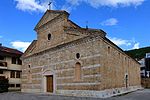
Back بريزرن Arabic بريزرن ARZ Prizren Azerbaijani Призрен Bashkir Прызран Byelorussian Призрен Bulgarian Prizren Breton Prizren BS Prizreni Catalan Prizren (kapital sa distrito) CEB
Prizren | |
|---|---|
City and municipality | |
| Coordinates: 42°12′46″N 20°44′21″E / 42.21278°N 20.73917°E | |
| Country | Kosovo |
| District | Prizren |
| Government | |
| • Type | Mayor–council |
| • Mayor | Shaqir Totaj (PDK) |
| • Council | Prizren Municipal Council |
| Area | |
• Municipality | 626.86 km2 (242.03 sq mi) |
| • Rank | 2nd in Kosovo |
| Population (2024)[1] | |
• Municipality | 147,428 |
| • Rank | 2nd in Kosovo |
| • Density | 240/km2 (610/sq mi) |
| Demonym(s) | Albanian: Prizrenas (m), Prizrenase (f) Serbian: Prizrenci/Призренци |
| Time zone | UTC+1 (CET) |
| • Summer (DST) | UTC+2 (CEST) |
| Postal code | 20000 |
| Area code | +383 (0) 29 |
| Vehicle registration | 04 |
| Website | kk.rks-gov.net/prizren/ |
Prizren (Albanian definite form: Prizreni, pronounced [pɾizˈɾɛni]; Serbian Cyrillic: Призрен) is the second most populous city and municipality of Kosovo and seat of the eponymous municipality and district. It is located on the banks of the Prizren River between the foothills of the Sharr Mountains in southern Kosovo. Prizren experiences a continental climate with some mediterranean influences.
Prizren is constitutionally designated as the historical capital of the country.[2] Archaeological excavations in Prizren Fortress indicate that its fortress area has seen habitation and use since the Bronze Age. Prizren has been traditionally identified with the settlement of Theranda in Roman Dardania, although other locations have been suggested in recent research. In late antiquity it was part of the defensive fortification system in western Dardania and the fort was reconstructed in the era of eastern Roman Emperor Justinian. Byzantine rule in the region ended definitively in 1219-20 as the Serbian Nemanjić dynasty took control of the fort and the town. Prizren served as the capital of the Serbian Empire under the reign of Stefan Dušan, as it bloomed to become an important center of trade and commerce during Dušan's reign. From 1371, a series of regional feudal rulers controlled Prizren, including the Mrnjavčević family, the Balšić noble family, and the Branković dynasty. Ottoman Turks captured Prizren from Serbian Despotate in 1455 and almost immediately served as the capital of Sanjak of Prizren in the Ottoman Empire. While standing as an important administrative city for the Ottomans, Prizren became an important political center for the Albanian National Awakening during the late 19th century.
The influence of Islam in Kosovo is evident; 96% of the population identified as Muslim in the most recent census, taken in 2011. Mosques, such as the Sinan Pasha Mosque, are a dominant feature in the town.
- ^ "Population and housing census in Kosovo preliminary results - July 2024" (PDF). Retrieved 21 July 2024.
- ^ "Ligji Nr. 06/L-012 për Kryeqytetin e Republikës së Kosovës, Prishtinën" (in Albanian). Gazeta Zyrtare e Republikës së Kosovës. 6 June 2018. Archived from the original on 24 September 2020. Retrieved 24 September 2020.










